Annual Maintenance in Support of Woodland Management
Woodland owners have different styles of management, from fairly casual to fairly regimented.
All different strategies can work, but there are annual maintenance, management and practical activities that are enjoyable, useful and support the objectives of many owners. An owner who develops a list of annual or regular activities, some that may require a short amount of effort, will be safer, more aware of natural changes in the woods, and better able to maintain safe and effective equipment. These activities can be done alone or with family members, and require relatively little investment of resources other than time.
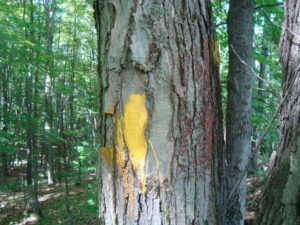
(Figure 1) This tree was previously blazed with an ax or machete to create the oval shaped wound. The healed blaze will be apparent for decades, but a fresh bit of paint makes the boundary tree more apparent from a distance.
Boundary line maintenance is a good activity each year. The inspection of the boundary marks and corner posts can happen any month, but the dormant season allows for easier visualization of the line. Some families do this as a group activity so children learn the boundaries and it becomes a legacy project. If the boundary has been previously marked, maintenance is as simple as using the previous color, or new color, of paint to refresh the boundary marks (Figure 1). If the property lines are posted, check to make sure the signs are intact and have the necessary information to be considered a legal posted sign. If the property lines were not previously marked, it is best to involve a professional surveyor, or minimally discuss the location with the adjoining owner.
Access trails are an essential asset of a wooded property. Most properties have some combination of old woods roads, enhanced paths or foot trails. These are useful for different modes of travel, but all benefit from regular inspection to look for fallen trees, hazard trees, poor access or erosion. This activity is likely best when the ground is visible, not snow covered, and for issues of access or erosion perhaps when the soils are wet or soggy so that problems are more obvious.
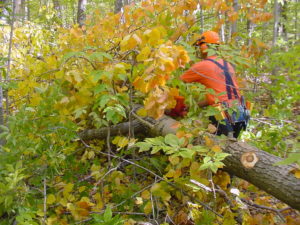
(Figure 2) Wind, snow and other events can create pile debris into your trails. Use extra caution because stems and limbs may be under unusual stress that result in a pinched bar or kick-back.
Use safe practices when removing downed logs (Figure 2), especially being alert to logs that are under tension or connected to standing dead trees. Hazard trees, those likely to fall on the trail, are often better left alone, but place a marker on the trail on either side of the tree to alert travelers. Solutions to erosion problems that are severe may benefit from professional guidance by your local Soil and Water Conservation District or forester. Similarly chronically soggy areas will need either control of the water, diversion of the source of water, or moving the trail to a new location.
A largely ubiquitous concern of owners is the health of their trees. Checking for tree health can be combined with other activities, or as a stand-alone walk in the woods a couple times per year. As a word of caution or comfort, the first time you go looking for tree health issues you may feel overwhelmed. A healthy woodlot will still have many examples of dead and dying trees. The goal is to identify extensive patterns of irregularity in trees. One instructive time to walk in the woods and assess tree health is shortly after the foliage emerges in the spring. In addition to helping cure cabin fever, this time of year allows the owner to inspect tree crowns for unusual changes in foliage expansion and development to full size.
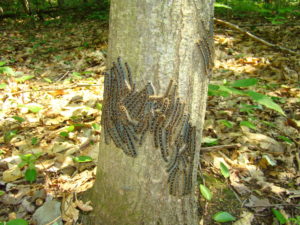
(Figure 3) Forest tent caterpillar is a native insect that impacts a several species, but especially sugar maple. By the time you see the larvae (a late stage is shown), it is too late to react. Monitoring in the winter for egg masses on twigs can allow for a timely response the following spring.
Some damaging insects, such as forest tent caterpillars, are active as leaves emerge (Figure 3); coordinating a treatment response at that time is unlikely, but you’ll be informed for the future. Another time is in the late summer when you can look for trees with early fall color that might indicate a summer drought or a problem with roots. A new phone app “HealthyWoods” will guide owners through a review of conditions in their woods and provide educational resources. HealthyWoods is available for iPhone and Android.
Many woodland owners have a variety of tools and machines that, like all tools and machines, need regular attention to be safe and effective. All tools with a cutting edge should be kept sharp as they are used throughout the year, but a once-over on all the tools lets you look for cracked handles, loose heads, or unusual wear and tear that might result in a break at an inopportune moment. Engines and mechanical devices each have an owner’s manual that will indicate a schedule of inspection and maintenance to ensure they function effectively and safely. Common maintenance tasks include ensuring you have a fresh supply of ethanol free gasoline (for non-diesel engines), change the oil, clean the air filters, lubricate moving parts, and change the spark plugs. Make a list of the materials you want to have on hand, such as extra bar oil, 2-cycle oil, extra spark plugs, or an extra chain.
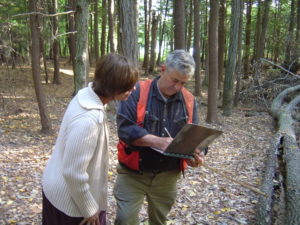
(Figure 4) It is helpful for woodland owners to periodically review their work schedule in their management plan. Try to involve your forester every few years to ensure you’re still on the right track.
Woodland owners with a written management plan can spend some time reviewing their work schedule. Those without a written management plan can contact the NYS DEC and ask for assistance from a service forester, who will write one without cost to the owner. The work schedule suggests annual activities that are designed to help the owner more fully enjoy their woods and optimally gain the benefits they desire (Figure 4). As the work schedule is reviewed, the owner can also create some type of journal to document their past efforts, what they accomplished and what they learned. One example of a creative solution to a journal is to annually make a copy of the property map, and use color pencils to highlight the year’s activities with marginal notes of lessons learned. For owners who are interested in generating revenue and who report expenses to the IRS, the journaling process provides an occasion to review your work records you kept during the year and make sure the actions, locations, dates, and receipts are clear.
Many of the non-native shrubs will expand their foliage earlier in the year than do native shrubs and plants. There is a window of a few weeks in late April or early May when the majority of the foliage in your woods belongs to non-native species.
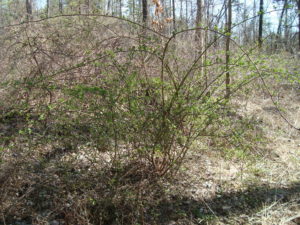
(Figure 5) Many of the invasive shrubs expand their foliage before native plants. Herbicides such as glyphosate products that are used as a foliar treatment can be applied in a short spring-time window when the invasive shrub has foliage and without collateral damage to desirable plants that have not expanded their foliage.
This is a good time to inspect your property for existing or new species, identify them, learn about why they became a problem, and what you can do to limit their spread or abundance. In many cases, non-native plants gain dominance because deer selectively eat only the native plant species and thus favors the growth of the non-native species. Owners can document the impact of deer with the AVID protocol that annually measures heights of tagged seedlings. The protocol can be found at www.AVIDdeer.com. Forest vegetation management to control the non-native species won’t solve a deer problem, but may limit the extent of an undesirable plant. In this springtime window, it is easy to find and focus attention on the non-native species. For owners who use foliar herbicides such as glyphosate, spray treatments to the non-native foliage will not impact species that have not expanded their foliage (Figure 5).
Although the activities suggested so far can be enjoyable, they are also at some level “work.” There are many other activities that are practical, but have a strong element of pleasure. One example is to have a walk once or twice a year to areas of your property you seldom visit and make sure that all the species you see are on your property’s “species list.” You can decide if this list is just trees, just wildflowers, birds or any combination of taxonomic groups. Once you add a species to the list, learn about the life history of that species. The life history attributes of a plant might include when it flowers, how the flowers are pollinated, how often there are bumper seed crops, what wildlife eat the fruit, if the plant has specific or general soil requirements, the plant’s shade tolerance, and more. Some of the species will be more special to you than others, and the life history attributes will allow you to develop a management scheme to favor their abundance.
A seasonal journal of nature in your woods is instructive to help you develop a keener sense of ecological patterns within a year and among years. This is a great activity to do with younger members of your “management team” so they can invest themselves in the property. The list of seasonal patterns can be as detailed as you like, but might include the dates of emergence of the leaves of specific trees, the date ice comes off the pond, when you hear the frogs and toads trilling, the number of days that the woodcock make their mating flight, first frost, last frost, or the day your favorite tree starts to turn its fall color.
Finally, a significant part of the joy of owning a woodlot is to share your wooded ecosystem with family and friends. This might include weekends to cut firewood, a gathering in the hemlocks for Thanksgiving, or the annual fishing derby in the pond. Set a time a few months before your event to make sure everyone knows about the event, and to make a list for necessary preparations.
Acknowledgments: My thanks to the many woodland owners from whom I’ve learned examples of annual activities, and how to make them fun.
This article originally appeared on www.ForestConnect.com, a program project of Cornell University Cooperative Extension and the NYS Department of Natural Resources. Support for ForestConnect is provided by the Cornell University College of Agriculture and Life Sciences and USDA NIFA through McIntire-Stennis and the Renewable Resources Extension Act.

